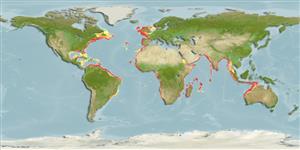Common names from other countries
>
Zeiformes (Dories) >
Zeidae (Dories)
Etymology: Zenopsis: Particle zen, derived from zao = to give life + Greek, opsis = appearance.
More on author: Lowe.
Issue
The spelling conchifera is considered as the correct one by some authors. To be verified.
Environment: milieu / climate zone / depth range / distribution range
Ekologi
marina bentopelagisk; djupintervall 50 - 600 m (Ref. 4968), usually 150 - 300 m (Ref. 36731). Deep-water; 58°N - 28°S
Atlantic Western Indian Ocean: Somalia (Ref. 30573) and India to South Africa, but not in the Red Sea. Eastern Atlantic: Bay of Biscay to South Africa. Western Atlantic: Sable Island, Canada to northern North Carolina, USA (Ref. 7251) to northern Argentina (Ref. 27363). Reported from the Mediterranean (Ref. 93173). Reported from Indonesia (Ref. 5978) but not in the Pacific Ocean.
Size / Vikt / Age
Maturity: Lm ? range ? - ? cm
Max length : 80.0 cm TL hane/ej könsbestämd; (Ref. 4253); common length : 50.0 cm TL hane/ej könsbestämd; (Ref. 5217); publicerad maxvikt: 3.2 kg (Ref. 7251)
Taggstrålar i ryggfenan (totalt) : 9 - 10; Mjukstrålar i ryggfenan (totalt) : 24 - 26; Taggstrålar i analfenan: 3; Mjukstrålar i analfenan: 24 - 26. Body silvery, with a dusky mid lateral spot just posterior to and slightly above end of pectoral fin (Ref. 4253). Fin membranes of spinous dorsal, pectoral, pelvic and caudal fins blackish (Ref. 27363).
Frequently encountered in coastal waters (Ref. 27000). Occurs near the bottom or in midwater, over muddy substrates (Ref. 5377). Mesopelagic (Ref. 5951). Found in small schools (Ref. 4968). Feeds on fishes (Ref. 5213) and squids (Ref. 5951). Minimum depth reported taken from Ref. 27363.
Life cycle and mating behavior
Maturities | Reproduktion | Spawnings | Egg(s) | Fecundities | Larver
Karrer, C. and A. Post, 1990. Zeidae. p. 631-633. In J.C. Quero, J.C. Hureau, C. Karrer, A. Post and L. Saldanha (eds.) Check-list of the fishes of the eastern tropical Atlantic (CLOFETA). JNICT, Lisbon; SEI, Paris; and UNESCO, Paris. Vol. 2. (Ref. 6953)
IUCN Red List Status (Ref. 130435)
CITES (Ref. 128078)
Not Evaluated
Threat to humans
Harmless
Human uses
Fiskeri: kommersiell
Verktyg
Special reports
Download XML
Internet-källor
Estimates based on models
Preferred temperature (Ref.
115969): 6.1 - 20.1, mean 13.6 (based on 418 cells).
Phylogenetic diversity index (Ref.
82804): PD
50 = 0.5781 [Uniqueness, from 0.5 = low to 2.0 = high].
Bayesian length-weight: a=0.01380 (0.01063 - 0.01792), b=2.93 (2.85 - 3.01), in cm Total Length, based on LWR estimates for this species (Ref.
93245).
Trofisk nivå (Ref.
69278): 4.5 ±0.0 se; based on diet studies.
Resiliens (Ref.
120179): Låg, lägsta populationsfördubblingstid 4,5-14 år (Assuming tm>4).
Fishing Vulnerability (Ref.
59153): Moderate to high vulnerability (52 of 100).
Climate Vulnerability (Ref.
125649): Moderate vulnerability (38 of 100).
